Archive for the ‘Fukushima’ Category
Radioactive Fukushima Water Leak Was Unreported for Months: Official
February 25th 2015
BY ARATA YAMAMOTO
NBC News
TOKYO — The operator of Japan’s tsunami-stricken Fukushima nuclear power plant admitted it failed to report a radioactive rainwater leak from the facility for about 10 months.
The company noticed a spike in radiation levels in the plant’s drainage system, particularly after rainfall, in April, according to a Tokyo Electric Power Company (TEPCO) official who spoke at a televised press conference on Tuesday.
"This was part of an ongoing investigation in which we discovered a water puddle with high levels of radiation on top of the Reactor No. 2 building, and because this also happens to be one of the sources for this drainage system, we decided to report everything all at once," the unnamed official said to explain why the findings weren’t reported immediately.
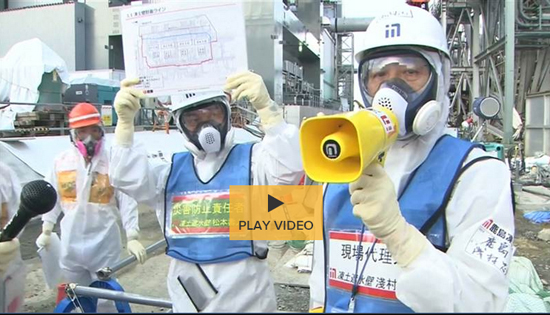
FROM JULY 2014: Fukushima Ice Wall Aims to Contain Leaks NBC NEWS
The puddle of contaminated rainwater contained cesium levels as high as 23,000 becquerels per liter, more than 10 times as high as radiation levels in sample water taken from other parts of the roof, according to TEPCO. It would implement measures to prevent further contamination by, for example, placing sandbags that absorb radioactive material in the area, TEPCO said.
Monitoring systems in nearby waters had not indicated any noticeable rise in radiation levels, the TEPCO official added.
TEPCO has been heavily criticized for its handling of the cleanup at Fukushima Daichi nuclear power plant since it suffered a meltdown at three reactors after a 9.0 magnitude earthquake off the coast on March 11, 2011.
The governor of Fukushima Prefecture Masao Uchibori criticized TEPCO’s withholding of information.
"It is extremely regrettable the swift release of information and the importance of that awareness — these basic things were not carried out," he said in comments carried by Nippon TV.
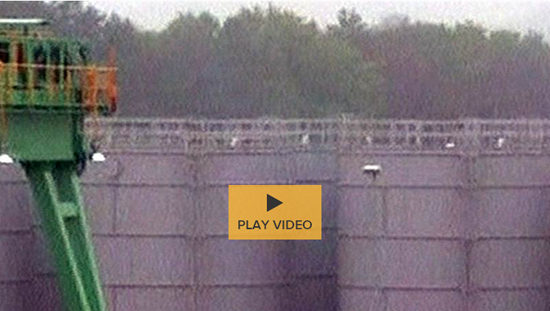
FROM JUNE 2013: Toxic levels found at Fukushima’s nuclear plant NBCNEWS.COM
Tsunemasa Niitsuma, a TEPCO executive officer, met with the local fishermen’s association on Wednesday.
"To those in the fishing industry, I would like to deeply apologize for the trouble and concerns we have caused," he said in comments carried by Nippon.
This was not enough for Masakazu Yabuki, the head of the fishermen’s cooperative in Iwaki City.
In comments carried by Nippon TV he said the damage was already done.
"In order to settle this crisis as quickly as possible, I realized I had to compromise and to do that I had to calm our fishermen and that’s because I trusted TEPCO," he said. "But with this one act, they betrayed me."
Reuters contributed to this report.
ARATA YAMAMOTO
Arata Yamamoto has been a NBC News producer in Tokyo, Japan, since 1993. He has worked on an array of stories, including the 2004 Asian tsunami, the 2011 tsunami and Fukushima nuclear disaster in Japan, and Haiyan typhoon that struck The Philippines in 2013.
This document contains copyrighted material whose use has not been specifically authorized by the copyright owner. SEED Coalition is making this article available in our efforts to advance understanding of ecological sustainability, human rights, economic democracy and social justice issues. We believe that this constitutes a "fair use" of the copyrighted material as provided for in section 107 of the US Copyright Law. If you wish to use this copyrighted material for purposes of your own that go beyond "fair use", you must obtain permission from the copyright owner.
Boxer: Nuclear regulators haven’t learned from Fukushima
12/03/14
By Timothy Cama
The Hill
Sen. Barbara Boxer (D-Calif.) accused the body responsible for nuclear energy safety of ignoring recommendations that sprung from 2011’s Fukushima Dai-ichi nuclear meltdown.
In the 10th hearing she has held on the disaster caused by an earthquake and tsunami, Boxer, chairwoman of the Environment and Public Works Committee, said regulators have not acted on any of the recommendations made after the disaster.
"The reality is that not a single one of the 12 key safety recommendations made by the Fukushima Near-Term Task Force has been implemented," Boxer told the five members of the Nuclear Regulatory Commission (NRC).
"There isn’t one of these that’s in place, not a single one," she said as an aide held a chart of the recommendations behind her.
Senior staffers and engineers at NRC made the recommendations months Fukushima in an effort to reduce the chances of a similar meltdown at nuclear power plants in the United States, or to mitigate its effects if it did happen.
Staffers told regulators to ensure that nuclear plants reevaluate flooding and seismic risks, improve staffing and communications for evacuation procedures, take steps to mitigate blackout effects, and other tasks.
NRC commissioners defended their actions over the last three years.
"The NRC continues to make significant progress in implementing post-Fukushima safety enhancements," said Allison MacFarlane, the commission’s chairwoman, who will step down soon.
She said plants are already starting to comply with other priorities from the task force, such as making improvements to the pools where they store spent fuel, installing diesel backup generators, and ensuring that all emergency equipment can be quickly and easily deployed.
"As a result of these activities, nuclear power plants in the United States will have more defense and depth to cope with long losses of offsite power and other severe accident conditions," she said.
Her fellow commissioners agreed.
"I’m very proud of the actions that we’ve required as an agency," said Commissioner William Ostendorf. "I believe that we take a thoughtful approach based in science, engineering and best principals to ensure that the right things are being done in the proper sequence."
Commissioner Kristine Svinicki agreed with MacFarlane and highlighted improvements to emergency equipment.
But Boxer wasn’t pleased.
"How can you say you’re proud of what you did?" she challenged MacFarlane. "I know you did a lot of other things that are good, but how you can say you’re proud that you helped us post-Fukushima, that’s beyond my ability to understand."
Boxer brought Rep. Lois Capps (Calif.), whose district includes California’s only operating nuclear plant, to back up her case.
"That tragedy put in such stark terms how little we actually knew about the seismic situation at Diablo Canyon and the potential consequences," she said.
This document contains copyrighted material whose use has not been specifically authorized by the copyright owner. SEED Coalition is making this article available in our efforts to advance understanding of ecological sustainability, human rights, economic democracy and social justice issues. We believe that this constitutes a "fair use" of the copyrighted material as provided for in section 107 of the US Copyright Law. If you wish to use this copyrighted material for purposes of your own that go beyond "fair use", you must obtain permission from the copyright owner.
Fukushima Fallout Damaged the Thyroids of California Babies
November 19, 2013
by CHRIS BUSBY
Counterpunch
A new study of the effects of tiny quantities of radioactive fallout from Fukushima on the health of babies born in California shows a significant excess of hypothyroidism caused by the radioactive contamination travelling 5,000 miles across the Pacific. The article will be published next week in the peer-reviewed journal Open Journal of Pediatrics.
Congenital hypothyroidism is a rare but serious condition normally affecting about one child in 2,000, and one that demands clinical intervention – the growth of children suffering from the condition is affected if they are left untreated. All babies born in California are monitored at birth for Thyroid Stimulating Hormone (TSH) levels in blood, since high levels indicate hypothyroidism.
Joe Mangano and Janette Sherman of the Radiation and Public Health Project in New York, and Christopher Busby, guest researcher at Jacobs University, Bremen, examined congenital hypothyroidism (CH) rates in newborns using data obtained from the State of California over the period of the Fukushima explosions.
Their results are published in their paper Changes in confirmed plus borderline cases of congenital hypothyroidism in California as a function of environmental fallout from the Fukushima nuclear meltdown. The researchers compared data for babies exposed to radioactive Iodine-131 and born between March 17th and Dec 31st 2011 with unexposed babies born in 2011 before the exposures plus those born in 2012.
Confirmed cases of hypothyroidism, defined as those with TSH level greater than 29 units increased by 21% in the group of babies that were exposed to excess radioactive Iodine in the womb [*]. The same group of children had a 27% increase in ‘borderline cases’ [**].
Contrary to many reports, the explosion of the reactors and spent fuel pools at Fukushima produced levels of radioactive contamination which were comparable with the Chernobyl releases in 1986. Using estimates made by the Norwegian Air Laboratory it is possible to estimate that more than 250PBq (200 x 1015) Bq of Iodine-131 (half life 8 days) were released at Fukushima.
This is also predicted by comparing the Caesium-137 estimates with I-131 releases from Chernobyl, quantities which caused the thyroid cancer epidemic in Byelarus, the Ukraine and parts of the Russian Republic.
More on this later. At Fukushima, the winds generally blew the radioactive iodine and other volatile radionuclides out to sea, to the Pacific Ocean. The journey 5,000 miles to the West Coast of the USA leaves a lot of time for dispersal and dilution. Nevertheless, small amounts of I-131 were measured in milk causing widespread concern.
The authorities downplayed any risk on the basis that the "doses" were very low; far lower than the natural background radiation. The University of Berkeley measured I-131 in rainwater from 18th to 28th March 2011 after which levels fell. If we assume that mothers drank 1 litre of rainwater a day for this period (of course they didn’t) the current radiation risk model of the International Commission on Radiological Protection (ICRP) calculates an absorbed dose to the adult thyroid of 23 microSieverts, less than 1/100th the annual background "dose". The foetus is more sensitive (by a factor of about 10 according to ICRP) but is exposed to less as it is perhaps 100 times smaller.
So this finding is one more instance of the fact that the current radiation risk model, employed by the governments of every nation, is massively insecure for predicting harm from internal radionuclide exposures or explaining the clear observations.
The Fukushima catastrophe has been dismissed as a potential cause of health effects even in Japan, let alone as far away as California. And on what basis? Because the "dose" is too low.
This is the mantra chanted by the International Atomic Energy Agency (IAEA), the World Health Organization (WHO, largely the same outfit), and the United Nations Scientific Committee on the Effects of Atomic Radiation (UNSCEAR). And let’s not forget all the nuclear scientists who swooped down on Fukushima with their International Conferences and placatory soothing presentations.
This chant was heard after Chernobyl, after the nuclear site child leukemias; in the nuclear atmospheric test veterans cases; and in all the other clear situations which in any unbiased scientific arena would long ago have blown away the belief that low level internal exposures are safe.
But this one-size-fits-all concept of "dose" is the nuclear industry’s sinking ship. It provides essential cover for the use of uranium weapons, whether fission bombs or depleted uranium munitions; for the development of nuclear power stations like Hinkley Point; the burying of radioactive waste in landfills in middle England; releases of plutonium to the Irish Sea from Sellafield (where it drifts ashore and causes increases in cancer on the coasts of Wales and Ireland); and most recently, for the British Governments denial of excess cancers among nuclear test veterans.
This new study is not the first to draw attention to the sensitivity of the unborn baby to internal fission products. In 2009 I used data supplied to me when I was a member of the UK government Committee Examining Radiation Risks from Internal Emitters (CERRIE) to carry out a meta-analysis of infant leukemia rates in five countries in Europe: England and Wales, Germany, Greece, and Byelarus.
There had been an unexpected and statistically significant increase in infant leukemia (age 0-1) in those children who were in the womb during the (whole body monitored) increased levels of Caesium-137 from Chernobyl. The beauty of this study (like the TSH study) is that, unlike the Sellafield child leukemias, there is really no possible alternative explanation.
It was the low "dose" of Caesium-137 that caused the leukemias. And the dose response trend was not a straight line:The effect at the very low "dose" was greater than at the very high "dose". Presumably because at the high doses the babies perished in the womb and could not, therefore, develop leukemia. I published the results and drew attention to the failure of the ICRP model in the International Journal of Environment and Public Health in 2009.
I had published a paper on this infant leukemia proof of the failure of the risk model inEnergy and Environment in 2000, and also presented it in the same year at the World Health Organisation conference in Kiev. It was there that I first really came up against the inversion of science deployed by the chiefs of the IAEA and UNSCEAR. The conference was videofilmed by Wladimir Tchertkoff and you can see his excellent documentary, which made it to Swiss TV, Atomic Lies, re-released in 2004 as Nuclear Controversies (link to youtube, 51 minutes).
For what is done by these people is to dismiss any evidence of increased rates of cancer or any other disease by shouting at it: "the doses were too low". In this way, reality is airbrushed away. What is this quantity "dose"? It is a simple physics-based quantity which represents the absorption of energy from radiation. One Sievert of gamma radiation is one Joule per kilogram of living tissue.
This might work for external radiation. But it doesn’t work for internal exposures to radioactive elements which can produce huge effects on cellular DNA at low average "doses". It is like comparing warming yourself in front of the fire with eating a hot coal. Or comparing a punch to stabbing. Same dose, same energy. Very different effects.
This "dose" scam has been used to dismiss real effects since it was invented in 1952 to deal with the exposures from nuclear weapons development and testing. For those who want to dig deeper into the science there is a recent book chapter I wrote in the book New Research Directions in DNS Repair.
The most scary instances of the sensitivity of the foetus to radiation are the sex ratio studies of Hagen Scherb, a German biostatician and member of the European Committee on Radiation Risk (ECRR). With his colleague Christina Voigt he has published a series of papers showing a sudden change in the sex ratio of newborns after various radiation exposure incidents.
Sex ratio, the number of boys born to 1,000 girls is a well accepted indicator of genetic damage and perturbations in the normal ratio of 1,050 (boys to 100 girls) are due to the deaths before birth of radiation damaged individuals of one sex or the other depending on whether the father (sperm) or mother (egg) was most exposed.
We found such an effect (more girls) in our study of Fallujah, Iraq, where there was exposure to Uranium weapons. But Scherb and Voigt have looked at the major catastrophes, Chernobyl, the weapons tests fallout, near nuclear sites in data from many countries of the world. Huge datasets.
They estimate that millions have babies have been killed by these subtle internal radiation exposures. The nuclear military project is responsible for an awful lot of deaths. In years to come I believe this will eventually be seen as the greatest public health scandal in human history.
Of course, the exposure to radio-Iodine is associated with thyroid cancer in children. There was a big rise of thyroid cancer in Byelarus, the Ukraine and the Russian Republic after Chernobyl. The situation at Fukushima seems set to echo this, despite the reassurances from the authorities that there will be no effects.
Our paper reports 44 confirmed thyroid cancer cases in 0-18 year olds in Fukushima prefecture in the last six months (a figure that has since risen to 53). In the hypothyroidism paper we discuss the 44 cases relative to the population and calculate that this represents an 80-fold excess based on national data prior to the Fukushima Iodine releases.
This presents a severe challenge to Dr Wolfgang Weiss of the UN and WHO, who stated last year that no thyroid cancers could result from the Fukushima disaster as the "doses were too low". How does he explain the 80-fold increase in this normally rare condition?
Or rather, when will he admit that the entire scientific model that underpins his views is fraudulent? And that nuclear radiation is – roughly speaking – 1,000 times more dangerous to human health than he is letting on?
Chris Busby is the Scientific Secretary of the European Committee on Radiation Risk. For details and current CV see www.chrisbusbyexposed.org. For accounts of his work see www.greeenaudit.org, www.llrc.org and www.nuclearjustice.org. This article originally appeared in The Ecologist.
For statisticians:
* RR 1.21, 95% CI 1.04-1.42; p = .013
** RR 1.27, 95% CI 1.2-1.35; p = .00000001.
This document contains copyrighted material whose use has not been specifically authorized by the copyright owner. SEED Coalition is making this article available in our efforts to advance understanding of ecological sustainability, human rights, economic democracy and social justice issues. We believe that this constitutes a "fair use" of the copyrighted material as provided for in section 107 of the US Copyright Law. If you wish to use this copyrighted material for purposes of your own that go beyond "fair use", you must obtain permission from the copyright owner.
West Coast of North America to Be Hit Hard by Fukushima Radiation
August 20, 2013
WashingtonsBlog
Radiation Levels Will Concentrate in Pockets In Baja California and Other West Coast Locations
An ocean current called the North Pacific Gyre is bringing Japanese radiation to the West Coast of North America:
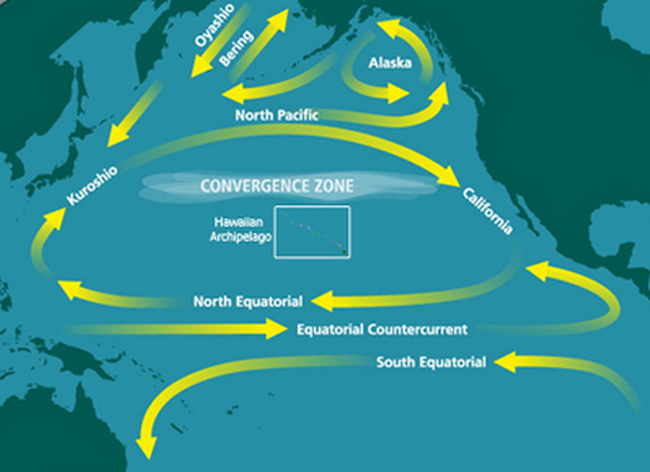
North Pacific Subtropical Convergence Zone FDA Refuses to Test Fish for Radioactivity … Government Pretends Radioactive Fish Is Safe
The leg of the Gyre closest to Japan – the Kuroshio current – begins right next to Fukushima:
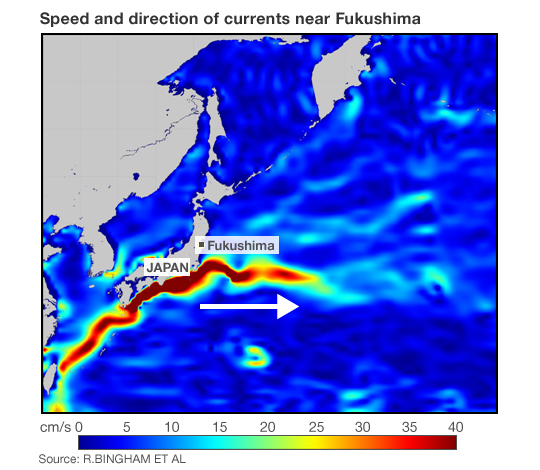
Kuroshio Current – Colour show water speed. Blue slowest; red fastest
While many people assume that the ocean will dilute the Fukushima radiation, a previously-secret 1955 U.S. government report concluded that the ocean may not adequately dilute radiation from nuclear accidents, and there could be "pockets"and "streams"of highly-concentrated radiation.
The University of Hawaii’s International Pacific Research Center created a graphic showing the projected dispersion of debris from Japan:

Last year, scientists from the National Oceanic and Atmospheric Administration’s (NOAA) Pacific Marine Environmental Laboratory and 3 scientists from the GEOMAR Research Center for Marine Geosciences showed that radiation on the West Coast of North America could end up being 10 times higher than in Japan:
After 10 years the concentrations become nearly homogeneous over the whole Pacific, with higher values in the east, extending along the North American coast with a maximum (~1 × 10-4) off Baja California.
***
With caution given to the various idealizations (unknown actual oceanic state during release, unknown release area, no biological effects included, see section 3.4), the following conclusions may be drawn. (i) Dilution due to swift horizontal and vertical dispersion in the vicinity of the energetic Kuroshio regime leads to a rapid decrease of radioactivity levels during the first 2 years, with a decline of near-surface peak concentrations to values around 10 Bq m-3 (based on a total input of 10 PBq). The strong lateral dispersion, related to the vigorous eddy fields in the mid-latitude western Pacific, appears significantly under-estimated in the non-eddying (0.5°) model version. (ii) The subsequent pace of dilution is strongly reduced, owing to the eastward advection of the main tracer cloud towards the much less energetic areas of the central and eastern North Pacific. (iii) The magnitude of additional peak radioactivity should drop to values comparable to the pre-Fukushima levels after 6–9 years (i.e. total peak concentrations would then have declined below twice pre-Fukushima levels). (iv) By then the tracer cloud will span almost the entire North Pacific, with peak concentrations off the North American coast an order-of-magnitude higher than in the western Pacific.
***
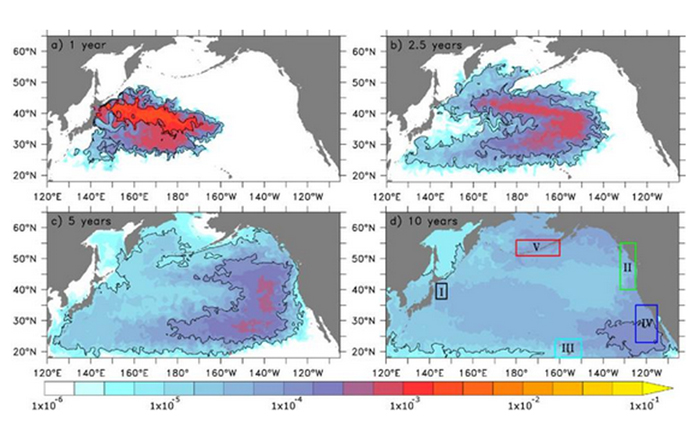
("Order-of-magnitude" is a scientific term which means 10 times higher. The "Western Pacific"means Japan’s East Coast.)
In May, a team of scientists from Spain, Australia and France concluded that the radioactive cesium would look more like this:
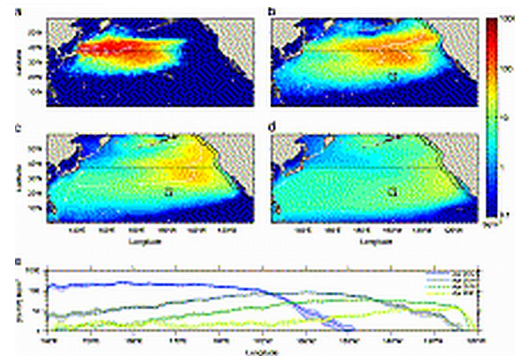
And a team of top Chinese scientists has just published a study in the Science China Earth Sciences journal showing that the radioactive plume crosses the ocean in a nearly straight line toward North America, and that it appears to stay together with little dispersion:
On March 30, 2011, the Japan Central News Agency reported the monitored radioactive pollutions that were 4000 times higher than the standard level. Whether or not these nuclear pollutants will be transported to the Pacific-neighboring countries through oceanic circulations becomes a world-wide concern.
***
The time scale of the nuclear pollutants reaching the west coast of America is 3.2 years if it is estimated using the surface drifting buoys and 3.9 years if it is estimated using the nuclear pollutant particulate tracers.
***
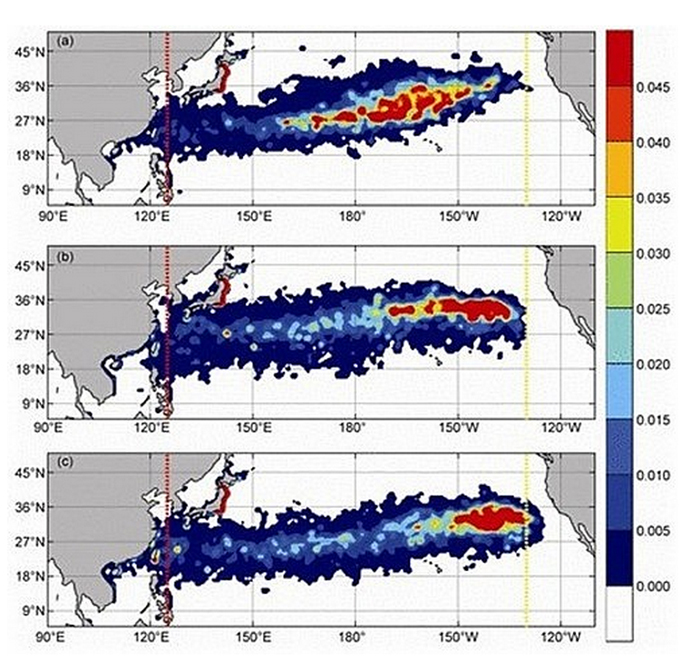
The half life of cesium-137 is so long that it produces more damage to human. Figure 4 gives the examples of the distribution of the impact strength of Cesium-137 at year 1.5 (panel (a)), year 3.5 (panel (b)), and year 4 (panel (c)).
***
It is worth noting that due to the current near the shore cannot be well reconstructed by the global ocean reanalysis, some nuclear pollutant particulate tracers may come to rest in near shore area, which may result in additional uncertainty in the estimation of the impact strength.
***
Since the major transport mechanism of nuclear pollutants for the west coast of America is the Kuroshio-extension currents, after four years, the impact strength of Cesium-137 in the west coast area of America is as high as 4%.
Note: Even low levels of radiation can harm health.
This document contains copyrighted material whose use has not been specifically authorized by the copyright owner. SEED Coalition is making this article available in our efforts to advance understanding of ecological sustainability, human rights, economic democracy and social justice issues. We believe that this constitutes a "fair use" of the copyrighted material as provided for in section 107 of the US Copyright Law. If you wish to use this copyrighted material for purposes of your own that go beyond "fair use", you must obtain permission from the copyright owner.
TEPCO says it ‘no longer owns’ Fukushima fallout
December 27, 2011
BY:RICK WALLACE, TOKYO CORRESPONDENT
The Australian
IN terms of sheer chutzpah, Tokyo Electric Power Co’s claim that it no longer owns the radioactive isotopes that spewed out of its Fukushima Daiichi nuclear plant in March takes some beating.
In defending a lawsuit from a Fukushima Prefecture golf club, lawyers said the radioactive cesium that had blighted the Sunfield Nihonmatsu golf course’s fairways and greens was the club’s problem. The utility has taken a similarly hard line defending claims from ryokan (inn) and onsen (spa) owners.
TEPCO’s lawyers used the arcane legal principle of res nullius to argue the emissions that escaped after the tsunami and earthquake triggered a meltdown were no longer its responsibility. "Radioactive materials (such as cesium) that scattered and fell from the Fukushima Daiichi nuclear plant belong to individual landowners, not TEPCO," the utility told Tokyo District Court.
The chief operating officer of the prestigious golf course, Tsutomo Yamane, told The Australian that he and his staff were stunned: "I couldn’t believe my ears. I told my employees, ‘TEPCO is saying the radiation doesn’t belong to them’, and they said ‘I beg your pardon’."
The court rejected TEPCO’s argument, but ruled it was the responsibility of local, prefectural and national governments to clean it up.
The case – and the club’s bid for $160 million in clean-up costs – has proceeded to the High Court amid fears the ruling could result in some local governments being bankrupted.
Mr Yamane said that, before the disaster, Sunfield Nihonmatsu, about 45km west of the stricken plant, was regarded as one of the region’s finest courses and was enjoyed by about 30,000 players a year.
He said the course was showered with fallout from the accident and sections of it were now reporting readings of almost double the criteria for evacuation of 20 millisieverts a year imposed by the Japanese government for regions around the plant.
"The highest radiation amount we measured on the course was 51 microsieverts per hour (in a drain). We are getting more and more concerned about the amount of cesium on the ground," Mr Yamane said.
"Up to the end of September there was still staff working to maintain the course, but on advice from the prefectural government we had to ask them to leave."
The club launched the lawsuit after being fobbed off by TEPCO’s compensation department. Mr Yamane said TEPCO was already using the District Court judgment as a legal battering ram to fend off lawsuits from other affected golf courses in Fukushima Prefecture.
"I wonder what’s up with today’s Japan," Mr Yamane said. "TEPCO used to keep saying nuclear power was safe and kept building plants in Japan.
"If that was true, the kind of problem we are seeing now should never have occurred."
This document contains copyrighted material whose use has not been specifically authorized by the copyright owner. SEED Coalition is making this article available in our efforts to advance understanding of ecological sustainability, human rights, economic democracy and social justice issues. We believe that this constitutes a "fair use" of the copyrighted material as provided for in section 107 of the US Copyright Law. If you wish to use this copyrighted material for purposes of your own that go beyond "fair use", you must obtain permission from the copyright owner.


